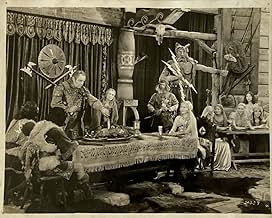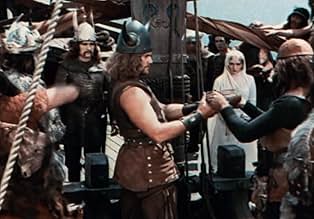Vikings compete for power and the love of a woman.Vikings compete for power and the love of a woman.Vikings compete for power and the love of a woman.
Anders Randolf
- Eric the Red
- (as Anders Randolph)
Harry Woods
- Egil
- (as Harry Lewis Woods)
Claire McDowell
- Lady Editha
- (as Claire MacDowell)
Iron Eyes Cody
- Indian
- (uncredited)
Frank Ellis
- Man Who Gives Sword to Alwin
- (uncredited)
Eugene McDonald
- Minor Role
- (uncredited)
Francis McDonald
- Viking Friend of Leif
- (uncredited)
Lon Poff
- Friar Slain by Vikings
- (uncredited)
Angelo Rossitto
- Viking Dwarf
- (uncredited)
Dick Sutherland
- Viking
- (uncredited)
- Director
- Writers
- All cast & crew
- Production, box office & more at IMDbPro
Storyline
Did you know
- TriviaWhen the film opened at the Embassy Theatre in New York City 28 November 1928, it was still silent and was accompanied by a live orchestral accompaniment. In December 1928 a musical score was recorded, sound-on-disc, and this version was distributed by MGM in 1929.
- GoofsViking women neither shaved their underarms nor wore the strapless bustiers.
- Quotes
Title Card: A thousand years ago, long before any white man set foot on the American shore, Viking sea rovers sailed out of the north and down the waterways of the world. These were men of might, who laughed in the teeth of the tempest, and leaped into battle with a song. Plundering - ravaging - they raided the coast of Europe - until the whole world trembled at the very name - THE VIKING.
- Crazy creditsThe title card bills the three stars in the order Pauline Starke [top billing], Donald Crisp [second billing], and Le Roy Mason [third billing]. But the opening credits end with "The Players" listed in the order: first "Leif Erickson ... Donald Crisp," second "Helga . . . Pauline Starke, third "Alwin . . . Le Roy Mason," etc. The characters appear on screen in the order Alwin, Helga, and Leif Erickson.
- ConnectionsFeatured in New England Legends: Creepy Christmas (2019)
Featured review
THE VIKING of 1928 still appears to be, in a way, a strikingly absorbing picture. Although it seems that any commitment to viewing this movie may be a privilege of some little group of film scholars, claiming that it leaves no impression whatsoever would surely belittle the significance of silent cinema along with its unique appeal. Obviously, it could not stand a chance against many modern 'pseudo-epic adventures' that heap us with cheap effects which, at moments, cross dangerous borderline placing us at risk of being deprived of imagination. With that in mind, its two strip Technicolor effects would merely appear laughable for some but, paradoxically, renewing for others. Yes, some of its awe-inspiring charm that initially contributed to its adventure merit, still remains.
A misleading assumption lies in a viewpoint that solely two strip Technicolor (for which the movie is most famous) makes THE VIKING worth seeing. Of course, it is impossible to miss this point when even mentioning this movie. Nevertheless, what strikes me most about this film is its storytelling and the fact that it evokes the courage of the Vikings no less than their cruelty. Meanwhile, it does not fall into temptation of reducing them to sheer savages from a purely subjective standpoint of 'baddies.' So to say, such an early achievement becomes authentic and, at the same time, gains realistic targets. It is not only executed in the character of Leif Eriksson (Donald Crisp) who travels towards the new shores but, even, in Erik the Red (Anders Randolf), his father. The sophisticated nature of his character is prompted by contrast within him. On the one hand, his axe is used against his political and religious enemies, even his own son when he discovers his new faith. One the other hand, he draws a very humane conclusion in a memorable scene: 'Leif is my son after all.
THE VIKING with no great stars of the time (being an MGM production), contains all the pictorial elements that we find in cinema of any decade. It substantially depicts love, revenge, fight. We have a Northumbria context of Alwin (LeRoy Mason), taken as a slave, we have a beautiful prototype of female warrior, Helga played by Pauline Starke (of course, a blonde beauty as it is a movie about the Vikings after all), we have kings of two opposing policies, we have this eternal conflict between Christian faith (represented by King Olaf of Norway and his followers, including Erik Leifsson) and pagan cults (represented by Erik the Red, Leif's father, the king of Greenland). Predictably, the Christians are depicted as loving, understanding and forgiving while the pagans are cruel. Yet, there is some nobility in both groups (again with reference to a more psychological approach). Their confrontation, however, is one of the most authentic moments of the theme ever found in silent cinema. Finally, we have the theme of new land, promised land, America (yes, long before Columbus) so much appealing to the audiences of the late 1920s.
But the film is no serious stuff and it should never be treated like one. It is, first and foremost, adventure and entertainment. Just to recall some scenes that have truly stood a test of time and are no less entertaining than they must have been in the late 1920s, including the depiction of Greenland, Vikings' feasts (less savage than in 1958 Fleischer's film), love plot between Alwin and Helga, Egil/Alwin vibrant fight. On the subject of Helga, the beautiful warrior blonde, much credit to Pauline Starke's inspiring performance. The idea of such a female character was not new in this period of silent films. We should remember the lost film QUEEN OF SHEBA and the famous chariot race of the queen and princess Vashti. Nevertheless, Starke's portrayal must have occurred revelatory as early as in 1928 combining appeal and authenticity.
I agree with the opinion of those viewers who praise this film and recommend others to seek it out. Perhaps, it is flawed historically; surely, it is no towering entertainment for viewers used to most dazzling spectacles of our decade. Nonetheless, I believe that anyone may find something for themselves in this early Technicolor treasure and find its reasonable running time fruitful and memorable.
A misleading assumption lies in a viewpoint that solely two strip Technicolor (for which the movie is most famous) makes THE VIKING worth seeing. Of course, it is impossible to miss this point when even mentioning this movie. Nevertheless, what strikes me most about this film is its storytelling and the fact that it evokes the courage of the Vikings no less than their cruelty. Meanwhile, it does not fall into temptation of reducing them to sheer savages from a purely subjective standpoint of 'baddies.' So to say, such an early achievement becomes authentic and, at the same time, gains realistic targets. It is not only executed in the character of Leif Eriksson (Donald Crisp) who travels towards the new shores but, even, in Erik the Red (Anders Randolf), his father. The sophisticated nature of his character is prompted by contrast within him. On the one hand, his axe is used against his political and religious enemies, even his own son when he discovers his new faith. One the other hand, he draws a very humane conclusion in a memorable scene: 'Leif is my son after all.
THE VIKING with no great stars of the time (being an MGM production), contains all the pictorial elements that we find in cinema of any decade. It substantially depicts love, revenge, fight. We have a Northumbria context of Alwin (LeRoy Mason), taken as a slave, we have a beautiful prototype of female warrior, Helga played by Pauline Starke (of course, a blonde beauty as it is a movie about the Vikings after all), we have kings of two opposing policies, we have this eternal conflict between Christian faith (represented by King Olaf of Norway and his followers, including Erik Leifsson) and pagan cults (represented by Erik the Red, Leif's father, the king of Greenland). Predictably, the Christians are depicted as loving, understanding and forgiving while the pagans are cruel. Yet, there is some nobility in both groups (again with reference to a more psychological approach). Their confrontation, however, is one of the most authentic moments of the theme ever found in silent cinema. Finally, we have the theme of new land, promised land, America (yes, long before Columbus) so much appealing to the audiences of the late 1920s.
But the film is no serious stuff and it should never be treated like one. It is, first and foremost, adventure and entertainment. Just to recall some scenes that have truly stood a test of time and are no less entertaining than they must have been in the late 1920s, including the depiction of Greenland, Vikings' feasts (less savage than in 1958 Fleischer's film), love plot between Alwin and Helga, Egil/Alwin vibrant fight. On the subject of Helga, the beautiful warrior blonde, much credit to Pauline Starke's inspiring performance. The idea of such a female character was not new in this period of silent films. We should remember the lost film QUEEN OF SHEBA and the famous chariot race of the queen and princess Vashti. Nevertheless, Starke's portrayal must have occurred revelatory as early as in 1928 combining appeal and authenticity.
I agree with the opinion of those viewers who praise this film and recommend others to seek it out. Perhaps, it is flawed historically; surely, it is no towering entertainment for viewers used to most dazzling spectacles of our decade. Nonetheless, I believe that anyone may find something for themselves in this early Technicolor treasure and find its reasonable running time fruitful and memorable.
- marcin_kukuczka
- Nov 10, 2013
- Permalink
- How long is The Viking?Powered by Alexa
Details
Box office
- Budget
- $325,000 (estimated)
- Runtime1 hour 30 minutes
Contribute to this page
Suggest an edit or add missing content





































